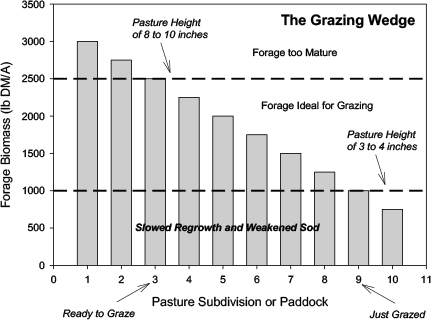Managing Spring Grass: Going from 0 to 60

Spring can often be one of the most challenging times of the year for graziers. Grass growth goes from nonexistent to excessive in a matter of weeks, and in many cases grazing livestock have a hard time keeping up with it. This can result in lower quality forage that is less palatable. The growth of new forage is also delayed by not removing the growing point of our cool-season grasses. The presence of the growing point suppresses tiller formation at the base of the grass plant. The following suggestions can help you to control spring growth and get the most out of your spring pastures.
- Implement rotational grazing. In order to fully utilize the spring flush of pasture growth, YOU must be in control of grazing. In a continuous grazing system, the cows are in charge.
- Start grazing before you think the pastures are ready. One of the most common mistakes that graziers make is waiting too long to start grazing in the spring. If you wait until the first paddock is ready to graze, by the time you reach the last paddock it will be out of control. Starting early allows you to establish a “grazing wedge” (Figure 1).
- Rotate animals rapidly. The general rule is that if grass is growing rapidly then your rotation should be rapid. This will allow you to stay ahead of the grass by topping it off and keeping it in a vegetative state.
- Do not apply spring nitrogen. Applying nitrogen in the spring will actually make the problem of too much grass at once even worse. In many cases, you are better off to save your nitrogen for stockpiling in the fall.
- Remove most productive paddocks from rotation and harvest for hay. Graze all paddocks until the pasture growth is just about to get away from you and then remove those productive paddocks from your rotation and allow them to accumulate growth for hay harvest.
- Increase stocking density in the spring. If it is possible, a good option for utilizing spring growth is to increase your stocking density. This will allow you to harvest more of the available forage and convert it into a saleable product. This can be done by adding some stockers or thin cull cows to your rotation and then selling them when pasture growth slows.
- Even out seasonal distribution of forage by adding a warm-season grass. Adding a well-adapted warm-season grass that produces the majority of its growth in July and August would allow you to increase your season-long stocking density to better utilize the spring flush of pasture growth.
- Bush-hog out of control pastures. The benefits of clipping include maintaining pastures in a vegetative state, encouraging regrowth, and controlling weeds. Clipping pastures costs money, so make sure that the primary reason for bush-hogging is pasture management, not aesthetics.
There is not a one-size fits all when it comes to grazing. One of the most important features to build into your grazing system is flexibility. This will allow you to adapt as situations change. Grazing systems are not static entities, but rather dynamic works of art that evolve as your skill level increases.
For more information on grazing management, contact your local extension agent or visit Forage Extension and KYForages on YouTube.
Categories:
Spring
Establishment/Renovation


